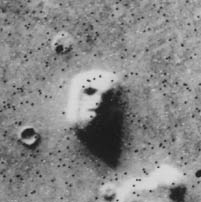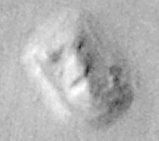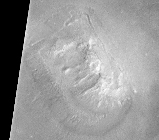
| Bad Astronomy |
|
|
|
BA Blog
|
|
Q & BA
|
|
Bulletin Board
|
| Media |
|
|
|
Bitesize Astronomy
|
|
Bad Astro Store
|
|
Mad Science
|
|
Fun Stuff
|
| Site Info |
|
|
|
Links
|
| RELATED SITES |
| - Universe Today |
| - APOD |
| - The Nine Planets |
| - Mystery Investigators |
| - Slacker Astronomy |
| - Skepticality |
Buy My Stuff

Keep Bad Astronomy close to your heart, and help make me
filthy rich. Hey, it's either this or one of those really
irritating PayPal donation buttons here.
Face to Face
Introduction
 Any discussion of Richard Hoagland would be incomplete without
discussing the "Face" on Mars. Basically, there is a
hill on Mars that is roughly a kilometer across. It was first
imaged by the Viking orbiter in the 1970s. It looks like a face.
Hoagland jumped on this, saying it didn't just look like a face,
it was a face, carved by aliens for unknown reasons. He
made this claim over and over, and then images taken later by
probes with higher resolution cameras showed it didn't look
much like a face at all. Hoagland then claimed that a) they
botched the image, making it look less like a face, and b) he
had predicted all along it wouldn't look like a face when better images were taken.
Any discussion of Richard Hoagland would be incomplete without
discussing the "Face" on Mars. Basically, there is a
hill on Mars that is roughly a kilometer across. It was first
imaged by the Viking orbiter in the 1970s. It looks like a face.
Hoagland jumped on this, saying it didn't just look like a face,
it was a face, carved by aliens for unknown reasons. He
made this claim over and over, and then images taken later by
probes with higher resolution cameras showed it didn't look
much like a face at all. Hoagland then claimed that a) they
botched the image, making it look less like a face, and b) he
had predicted all along it wouldn't look like a face when better images were taken.
Despite these mutually contradictory claims, Hoagland is still pounding
the face, as it were. Now that newer images show it isn't
a "Face", he has jumped ship so to speak and is looking
to other, equally silly and wrong
arguments about aliens on Mars.
But the "Face" keeps coming up on the web, and people
still talk about it. So let's take a look at it.
Viking, Ho!
First off, there isn't anyone I know of who would deny it looks
like a face in the Viking image. It does. In fact, when the printout
was first made of the image, someone actually wrote "Face!"
on it. I'm not surprised; I have seen thousands of astronomical images,
and when something weird and funny pops up, it draws attention.
In various images I have seen
the USS Enterprise,
a smiley face,
and even what looks for all the world like a nebula
giving us the finger.
When astronomers spot these types of things, we laugh, and tell our colleagues.
When that last one came up, we had printouts of it everywhere, and
we laughed about it for weeks. So it's no shock that someone commented
on the Mars face image.
After the image came out, Hoagland stumped everywhere for it, making all sorts of claims. He even wrote a book about it, "The Monuments of Mars" where he discusses the "Face" at length, showing models of it from different angles, different lighting, etc. He makes outrageous claims about the "Face", such as this one on page 169, where he quotes Greg Molenaar:
| If a mountain clump on Mars looks like a carved humanoid face, the most simple explanation may be... that it is. |
That's just plain wrong. The simplest explanation is that it is
carved by erosion, and not the hands (or tentacles
or feelers) of aliens. We know that such things happen
all the time. Look at The Old Man of the Mountain, a rock
formation that (until it collapsed in 2003) looked a lot like
a face.
Snapdragon seed capsules look more like faces. And of course,
don't forget
Vladmir Lenin, who appeared in my shower
curtain. Seeing faces in semi-random or random patterns
is called
pareidolia, and is a well-understood psychological phenomenon.
I MOC Thee!
Hoagland also presents several images of the hill
processed using techniques
which "clean up" the original image.
Without having the raw data on hand, I am not sure how valid his
methods are. He goes on at length on his site about them, but I've
learned not to trust his word. However,
it so happens I know a bit about astronomical image processing,
having done it for a decade or so. I know that even the best techniques
are noisy, and they are no substitute for better, higher-resolution
images. So in all honesty, I don't care all that much about any cleaned Viking
images. They aren't terribly meaningful, despite his claims of seeing all
sorts of detail in them (including
teeth, a pupil in the eye, etc.).
It wasn't until September, 1997, that a new orbiting camera entered orbit around Mars. The Mars Global Surveyor, equipped with the Mars Orbiter Camera, took new images of the Cydonia region in 1998 (more on how this happened in a moment). The images released were, unsurprisingly, unsupportive of the idea that the face was a "Face". It showed the face to be an eroded mesa. It is interesting for many reasons, but I wouldn't include artificiality in that list.

|

|
| Just another... | ... face in the crowd |
This hasn't stopped Hoagland, of course. He protested the way the image was processed, the way it was released, the method used to take it, the methods not used to take it, anything to distract from the fact that no matter what, it just doesn't look like a real face. This is overlooked a lot, and it's really a key part: while it still looks vaguely like a face, it is clearly not at all like a representation of a human face. Hoagland, hedging his bet, claims that he never said that when better images were available, it was going to look symmetric, or exactly like a human face. This statement by him is, at best, a cop out. He spent years saying it was a face, a human or humanoid face, on any venue that would have him. Well, sorry. Better images have turned up, and while Hoagland has now changed his tune somewhat, it doesn't matter. He was wrong then, and he's wrong now.
Another point people don't seem to consider is that, had we had the better-resolution images first, no one would have given that hill a second look. Its resemblance to a face is great at lower res, but at higher res it's just a hill. I think this is not only a valid point, but a very salient one: Hoagland's arguments don't work backwards. If it doesn't look like a face in a higher-resolution, early image, and does in a lower-resolution later image, then he has no leg to stand on. So why should anyone listen to him if the order is swapped?
Whose Conspiracy Is It, Anyway?
Again, this hasn't stopped him. His cries of conspiracy continue. For example, the higher-resolution image was accompanied by a profile of the face taken by an instrument which uses pulses of laser light to measure heights of objects. It's similar to the way a dolphin or bat uses sound to measure the distances to nearby objects. This instrument, called the Mars Orbiting Laser Altimeter, or MOLA, doesn't have nearly the resolution of the camera that took the images, but unlike the camera yields very good heights for vertical objects. The data were shown next to the camera images to give an idea of how big the face hill was. Hoagland, however, grossly mischaracterizes this:
| Or, to put it another way: NASA is basing its entire public 'its just a hill' argument on a MOLA 'image' that is six times worse than the 25-year-old Viking data! |
Once again, Hoagland is pulling a sleight-of-hand: the MOLA
images were not being used to justify the "just a hill" argument,
they were augmenting the very conclusive images from the MOC! He has mischaracterized
the NASA arguments in such a way as to mislead anyone reading his web page.
That's a big no-no.
The Real Deal
Luckily, we need not rely only on Hoagland's dubious claims about
this structure. Mike Malin, whose company
Malin Space Science Systems
built the MOC, has several pages dealing with the reality of the face hill.
Here are several pages from the MSSS website:
- How they processed the Viking image
- The first MOC release of the region
- The second image release
- A page with a very high resolution image of the face, as well as a 3D anaglyph!
- A summary of their work
- Hoagland made a lot of nonsense claims about MSSS purposely messing up the MOC images of the Cydonia region. Malin responded with, yes, real science.
|
|
|
|